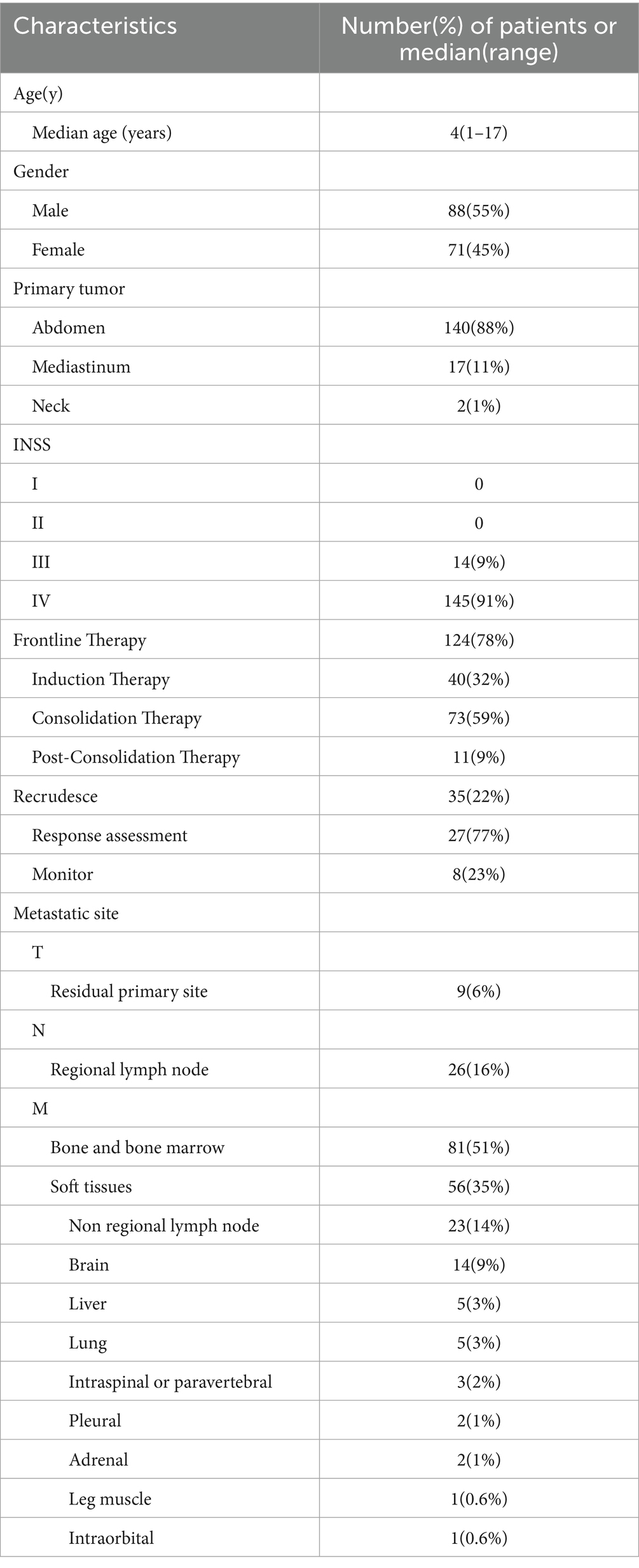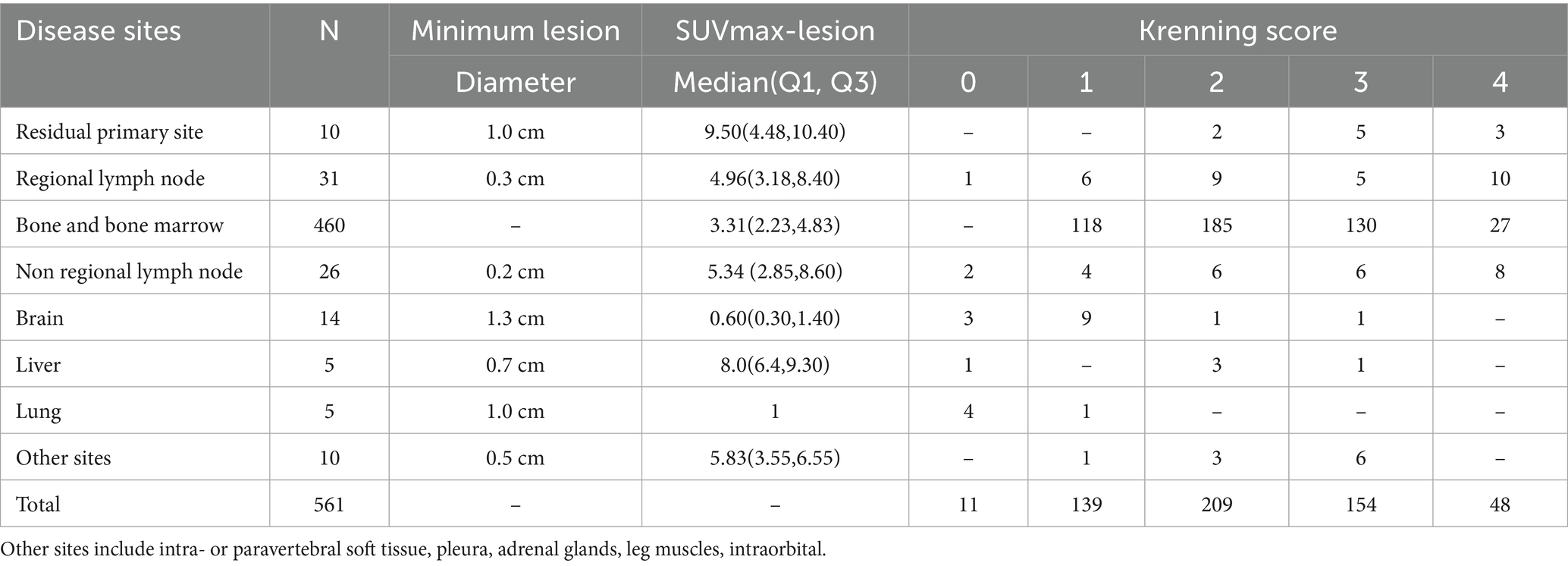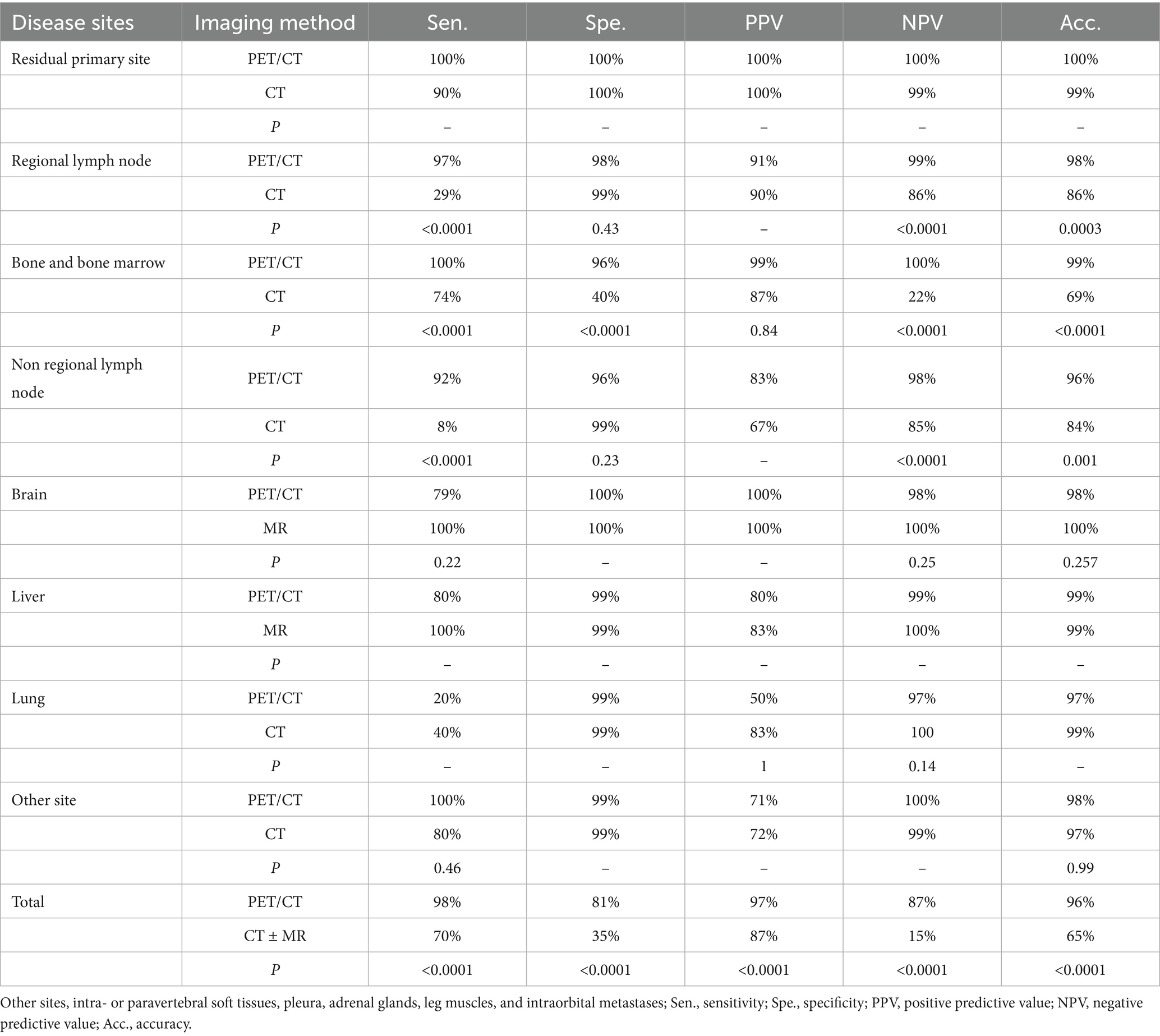- 1Department of Nuclear Medicine, Shandong Cancer Hospital and Institute, Jinan, China
- 2Department of Nuclear Medicine, Sichuan Provincial People's Hospital East Sichuan Hospital & Dazhou First People's Hospital, Dazhou, China
- 3Department of Pediatric Oncology, Shandong Cancer Hospital and Institute, Jinan, China
Purpose: To evaluate the value of 18F-AlF-NOTATATE PET/CT in restaging high-risk neuroblastoma (NB) after chemotherapy and its advantages over anatomical imaging.
Materials and methods: We retrospectively collected data from high-risk patients with NB who were restaged after chemotherapy using 18F-AlF-NOTATATE PET/CT between June 2021 and June 2022. The histopathological, clinical, and radiographic follow-up results were used as reference standards for the final diagnosis. Patient- and lesion-based analyses were performed. The chi-square test was used to compare the efficacy between 18F-AlF-NOTATATE PET/CT and anatomical imaging for the detection of residual lesions. One-way ANOVA was used to compare the difference between the maximum standard uptake (SUVmax) values of false-positive and true-positive residual lesions in the surgical subgroups.
Results: Exactly 159 high-risk patients with NB underwent 18F-AlF-NOTATATE PET/CT restaging. Exactly 134 patients had 634 residual lesions, and the true-positive rate was 88.5%. Among the residual NB lesions, distant and regional lymph node metastases accounted for 86 and 16%, respectively. In the lesion-based analysis, the sensitivity, specificity, positive predictive value (PPV), negative predictive value (NPV), and accuracy of 18F-AlF-NOTATATE PET/CT were significantly higher than those of anatomical imaging. In the patient-based analysis, the specificity, PPV, and accuracy of 18F-AlF-NOTATATE PET/CT were also significantly higher. In the surgical subgroup, the SUVmax of false-positive lesions was significantly lower than that of NB.
Conclusion: The efficacy of 18F-AlF-NOTATATE PET/CT in restaging high-risk NB after chemotherapy is significantly superior to anatomical imaging. Although, the SUVmax may help identify false-positive lesions, it cannot distinguish benign transformation after NB treatment.
Introduction
Neuroblastoma (NB) is the most common extracranial malignant solid tumor in children, accounting for 8–10% of all malignant tumors in children, with a mortality rate of up to 15% (1). It typically occurs in children younger than 10 years, with a median age of 18 months at diagnosis. Nearly 60% of patients have already developed metastases at the time of diagnosis, with the most common sites of metastasis being the bone and bone marrow, followed by the lymph nodes (2–4). The treatment plan for high-risk NB includes three phases: Induction Therapy (surgery + chemotherapy), Consolidation Therapy (sequential transplantation + consolidation radiotherapy for the primary site), and Post-Consolidation Therapy (immunotherapy + 13-CRA treatment). The overall survival rate of high-risk patients with NB is less than 50% (1, 4). Therefore, accurate and reliable imaging methods are crucial for determining optimal treatment strategies. However, traditional anatomical imaging techniques, such as ultrasound (US), computed tomography (CT), and magnetic resonance imaging (MRI), have relatively low sensitivity and specificity for the diagnosis and assessment of NB.
NB express norepinephrine transporters that can be labeled with mesoiodobenzylguanidine (MIBG). 123I-MIBG imaging has a high sensitivity (88–92%) and specificity (83–92%) for NB and its metastatic foci. Moreover, it has been widely used for the diagnosis of NB, evaluation of the initial treatment, and detection of response to NB treatment (5). However, the accessibility of MIBG imaging in China and its ability to detect small lesions are limited. Compared with MIBG imaging, 18F-Fluorodeoxyglucose (18F-FDG) PET/CT is less specific for NB and is currently used as a second-line imaging agent, mainly in patients with NB who have negative MIBG uptake and who cannot uptake MIBG during or after treatment (6). The NB surface somatostatin receptors (SSTR) is usually overexpressed in patients with the condition. In recent years, 68Ga-labeled somatostatin analog (68Ga-SSA) PET/CT has shown potential benefits in the restaging of NB and the assessment of treatment response (7). However, the high cost of 68Ge/68Ga generators and the short half-life of 68Ga have hindered the application of 68Ga-labeled tracers (8). Recently, 18F-AlF-NOTA-Octreotide (18F-OC) was shown to be a promising tracer for SSTR imaging (9). It has been shown that 18F-OC can be an effective alternative to 68GA-DOTA-Octreotide (68GA-OC) for SSTR PET/CT imaging in patients with Neuroendocrine Tumor (NET) and has better detection efficacy for liver lesions (10). However, the clinical value of 18F-OC PET/CT in pediatric patients with NB requires further investigation.
This retrospective study aimed to evaluate the value of 18F-AlF-NOTATATE PET/CT in restaging high-risk NB after chemotherapy and compare it with conventional imaging (co-located CT ± contemporaneous liver/brain-enhanced MRI).
Materials and methods
This retrospective study was approved by the appropriate Ethics Committee, and the patients signed an informed consent form. Data from high-risk patients with NB who underwent 18F-AlF-NOTATATE PET/CT for restaging between June 2021 and June 2022 were retrospectively collected. Contemporaneous (within 1 month) liver- and brain-enhanced MR scan results were obtained from the enrolled patients. The inclusion criteria were as follows: (1) pediatric patients (age ≤18 years); (2) pathologically confirmed NB; (3) previous induction, consolidation, or post-consolidation chemotherapy; (4) risk stratification as a high-risk group; and (5) complete clinical and follow-up data. The results of the patient’s biopsy (referred to as biopsy) or reoperation with postoperative pathology, laboratory tests, and clinical and imaging follow-ups (at least 6 months) were used as the gold standard for the final diagnosis.
All images were acquired on a PET/CT scanner (Biographversion; Siemens, Germany). PET tracers were automatically produced with labelled nuclide 18F using the accelerator MINI trace from GE, USA, 18F-AlF-NOTATATE with ≥95% purity of the putative.
All images were acquired using a PET/CT scanner (Biograph version; Siemens, Germany), which scanned from the top of the skull to the soles of the feet after intravenous administration of 18F-AIF-NOTATATE at a dose of 3.3 to 4.44 MBq/kg. Fasting and normal blood glucose levels were not assessed. 18F-AIF-NOTATATE PET/CT was performed 2 weeks after chemotherapy and somatostatin analog treatment. A PET scan was performed with 3 min per frame 3D acquisition. Low-dose CT (120 kV) was performed for attenuation correction, and all corrections were applied to the reconstructed images to provide anatomical information. All data were reconstructed using an iterative algorithm (Siemens).
The PET images were reviewed by two experienced nuclear medicine physicians in a blinded manner, and disagreements were discussed and resolved. Increased 18F-AlF-NOTATATE PET uptake above the surrounding tissue background, with/without morphological changes, was considered a positive lesion when physiologic uptake and definite benign disease were excluded. A negative diagnosis was made when PET did not show abnormal concentrations. The region of interest was outlined by selecting the site with the highest concentration on the 3D image. The maximum standardized uptake value (SUVmax) of all positive lesions was measured, and the lesions were scored according to the Krenning score (11) (0 = no uptake; 1 = uptake above background but less than liver; 2 = uptake slightly less than or equal to liver; 3 = uptake greater than liver; 4 = uptake greater than spleen). The total number of bone lesions per patient was calculated by PET and CT. Multiple and diffuse uncountable lesions were arbitrarily divided into 10 groups. The nuclear medicine physicians were also asked to characterise the bone lesions (dissolving, sclerotic or mixed) on the basis of visual analysis.
Following the 18F-AIF-NOTATATE PET/CT examination, all patients will undergo a one-week follow-up to meticulously monitor and document any adverse reactions associated with this diagnostic procedure. These adverse reactions include fever, edema, pain, nausea, vomiting, diarrhea, and injection site reactions. According to the common terminology criteria for adverse events (CTCAE) issued by the National Cancer Institute (NCI) under the National Institutes of Health (NIH), the above adverse reactions were graded to evaluate their severity.
Statistical analyses were performed using IBM SPSS software (version 26.0). The χ2 test was used to compare the efficacy of 18F-AlF-NOTATATE PET/CT with that of conventional anatomical imaging for residual lesion detection. One-way ANOVA was also used to compare the difference in SUVmax between false-positive and true-positive residual lesions in the surgical subgroups. The level of statistical significance was set at p < 0.05.
Results
Among 159 children, 88 (55.3%) were boys and 71 (44.6%) were girls. These patients did not experience any adverse reactions caused by the radiotracer 18F-AlF-NOTATATE after undergoing PET/CT. Exactly 124 (78%) patients were treated with first-line therapy for high-risk NB, and 35 (22%) experienced recurrence. Of these, 634 positive lesions were found in 134 patients, and 561 (95.9%) were confirmed as true-positive lesions by postoperative pathology and imaging follow-up (n = 54, determined by postoperative pathology; n = 507, determined by imaging follow-up). The primary tumor sites included the retroperitoneum in 144 patients (88%), the posterior mediastinum in 17 patients (11%), and the neck in two patients (1%). Residual lesions after induction, consolidation, or post-consolidation chemotherapy were mainly located in distant metastases in approximately 86% of the cases, with bone and bone marrow metastases accounting for the highest percentage (60%), followed by regional lymph nodes, non-regional lymph nodes, the brain, the primary site, the liver and lungs, the intra- or paravertebral soft tissues, the pleura and adrenal glands, and the muscles and intraorbital soft tissues in that order. Fifteen of the 25 negative patients underwent chemotherapy after PET imaging. The median follow-up period was 251 days, and eight patients did not experience recurrence. The patient characteristics are detailed in Table 1.
18F-AlF-NOTATATE PET/CT detected NB lesions with a minimum diameter of 1.0 cm for primary residual/recurrent metastasis, 0.2 cm for lymph node metastasis (0.3 cm for regional lymph nodes and 0.2 cm for non-regional lymph nodes), and 0.5 cm for non-lymph node distant metastasis. In addition, of the 460 18F-AlF-NOTATATE PET/CT high uptake bone and bone marrow metastatic lesions, 341 bone and bone marrow metastatic lesions had morphologic and density abnormalities, with predominantly osteolytic changes (48.7%, 166/341). Osteogenic changes accounted for approximately 43.7% of the cases. Residual bone and bone marrow lesions were predominantly found in the limb bones, followed by the vertebrae, pelvis, maxillofacial bones, and skull.
Based on the Krenning score, the degree of uptake in NB lesions reported using 18F-AlF-NOTATATE PET/CT was predominantly 1–2 points in 62% of the cases, 3 points in 27%, and 4 points in 9%. Table 2 presents the 18F-AlF-NOTATATE PET/CT SUVmax and Krenning scores for the different disease sites.
In the lesion-based analysis, the sensitivity, specificity, positive predictive value (PPV), negative predictive value (NPV), and accuracy of 18F-AlF-NOTATATE PET/CT and co-located CT ± contemporaneous liver/brain-enhanced MRI were 98.0, 80.7, 97.0, 86.6, and 95.7% and 69.5, 35.2, 87.2, 15.3, and 64.9%, respectively. In Table 3, the detection rates of the two imaging modalities for different disease sites are reported based on the final total number of true lesions.
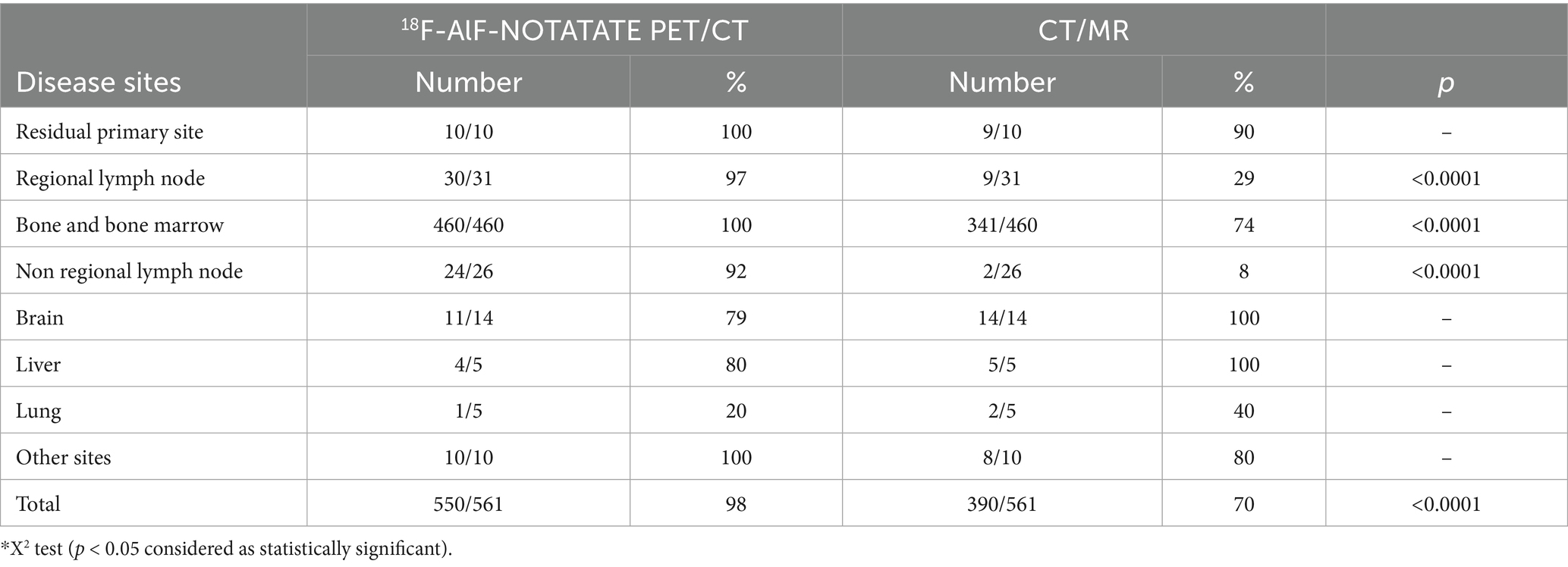
Table 3. Detection rates of 18F-AlF-NOTATATE PET/CT versus CT/MR per site of disease, according to total number of true lesions at final outcome.
The superior sites for residual lesion detection by SSTR PET/CT were regional/non-regional lymph node, bone, and bone marrow metastases. For residual lesion detection at the primary site, there was no difference in diagnostic performance between 18F-AlF-NOTATATE PET/CT and conventional imaging; however, 18F-AlF-NOTATATE PET had higher sensitivity (100%) and accuracy (100%) than conventional imaging (90 and 99%, respectively). For regional lymph node lesion detection, 18F-AlF-NOTATATE PET/CT was significantly superior to conventional imaging, with sensitivities of 97 and 29% (p < 0.0001) for 18F-AlF-NOTATATE PET/CT and conventional imaging, respectively, and accuracies of 98 and 86% (p = 0.0003), respectively. For the detection of distant metastatic lesions, the diagnostic efficacy of 18F-AlF-NOTATATE PET/CT for bone and bone marrow metastases and non-regional lymph node metastatic lesions was significantly better than that of conventional imaging.
18F-AlF-NOTATATE PET/CT revealed 17 false-positive lesions, including seven cases of ganglion cell neuromas (two cases involving the lymph nodes, two involving the leg muscles, one involving the liver, one involving the left adrenal gland, and one involving the right pleura), six cases of inflammatory lymph nodes, three cases of benign bone lesions, and one case of lung inflammation. Figure 1 illustrates a case of high-uptake ganglion cell neuroma in the left adrenal gland.
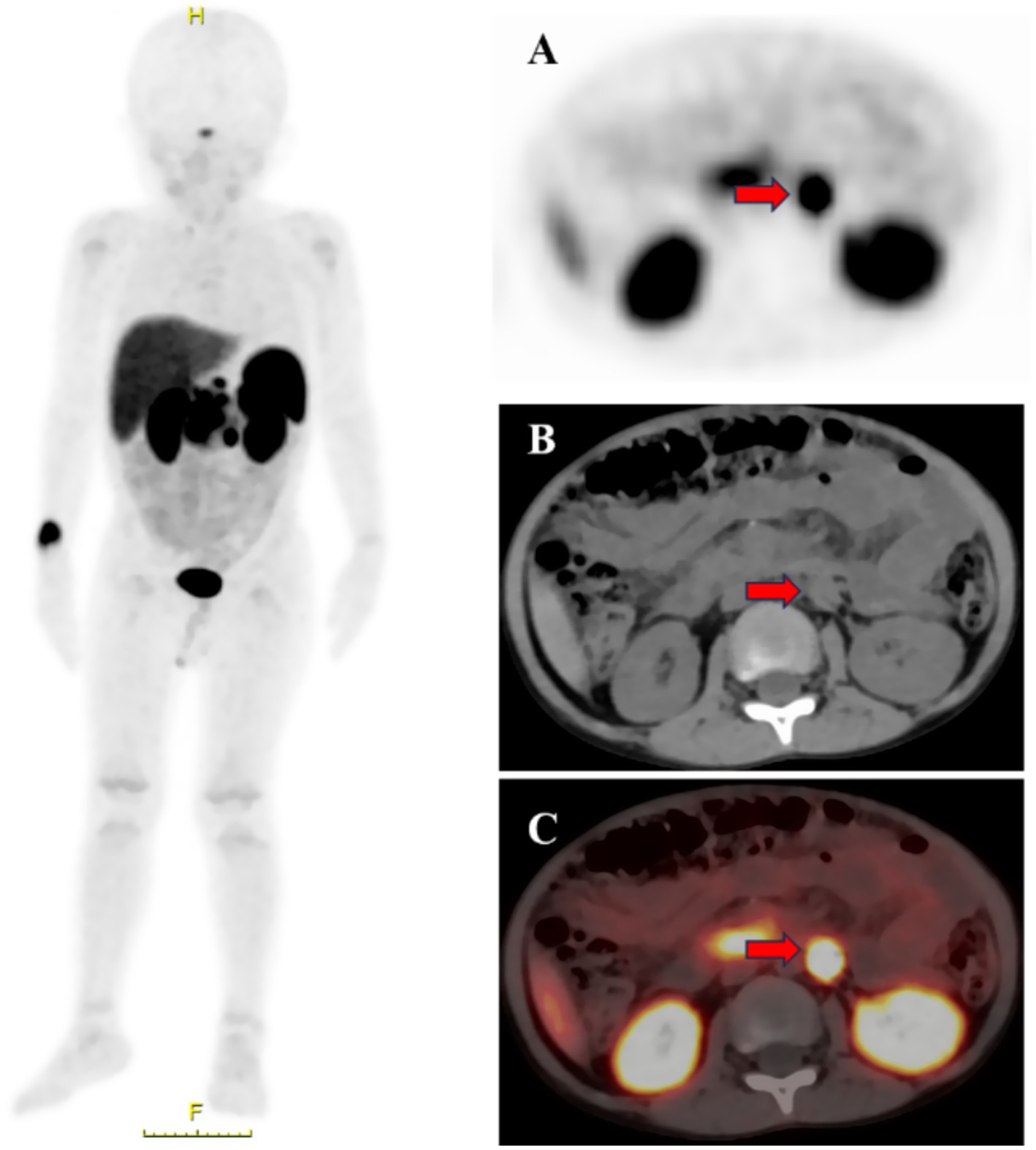
Figure 1. The primary site was located in the retroperitoneum in a child (male, 4 years old), PET showed [(A), red arrow] a rounded hyperintense focus in the left adrenal region; CT on the same machine showed [(B), red arrow] a rounded nodular focus in the left adrenal region with a diameter of approximately 0.9 cm; PET/CT showed [(C), red arrow] a rounded hyperintense focus in the left adrenal region with an SUVmax of 17.9. The final reopening postoperative pathology the diagnosis of ganglion cell neuroma was confirmed.
18F-AlF-NOTATATE PET/CT revealed 11 false-negative lesions, including four in the lungs, three in the brain, three in the lymph nodes, and one in the liver. Lymph node metastatic lesions in the retroperitoneum are illustrated in Figure 2.
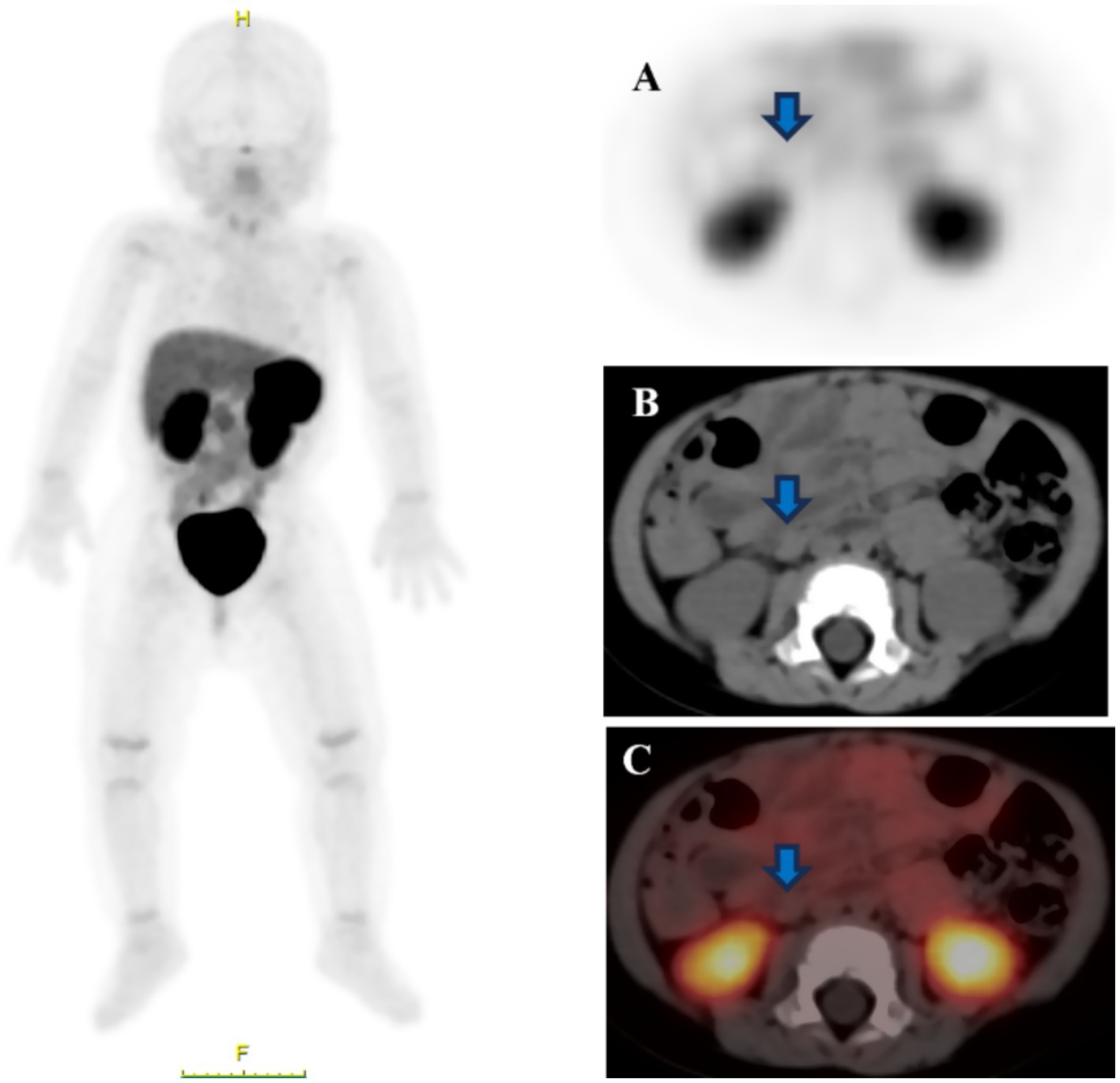
Figure 2. The primary site was located in the retroperitoneum in a child (female, 3 years old), and CT on the same machine showed [(B), blue arrow] a retroperitoneal lymph node with a diameter of approximately 0.5 cm; both PET and PET/CT [(A), blue arrow; (C), blue arrow] did not show any high uptake of nodal foci in the same area. The final reoperation pathology confirmed the diagnosis of metastatic neuroblastoma.
In the patient-based analysis, the sensitivity, specificity, PPV, NPV, and accuracy of 18F-AlF-NOTATATE PET/CT and co-located CT ± contemporaneous liver/brain-enhanced MRI were 96.9, 89.4, 93.2, 95.1, and 93.9%, and 96.9, 53.0, 75.6, 92.1, and 69.3%, respectively. Moreover, SSTR PET was significantly more specific in terms of restaging, PPV, NPV, and ACC. Data regarding the diagnostic efficacies of patient-based 18F-AlF-NOTATATE PET/CT and conventional imaging for NB are presented in Table 4.
Seventy-three lesions were surgically resected, and the pathological findings after reoperation were NB (n = 54, SUVmax = 6.70 (3.67,10.00)), ganglion cell neuroblastoma (GNB, n = 6, SUVmax = 1.46 (2.06,4.44)), ganglion cell neuroma (GN, n = 7, SUVmax = 9.20 (2.72,12.05)), and false-positive lesions (n = 6, SUVmax = 2.01 (1.70,2.23)). One-way ANOVA revealed that the difference in SUVmax among NB, GNB, GN, and the false-positive lesions was statistically significant (p = 0.036). Moreover, there was a difference in SUVmax between NB and false-positive lesions. The SUVmax of the false-positive lesions was significantly lower than that of the NB lesions; however, it was not statistically different from the GNB and GN lesions (Figure 3).
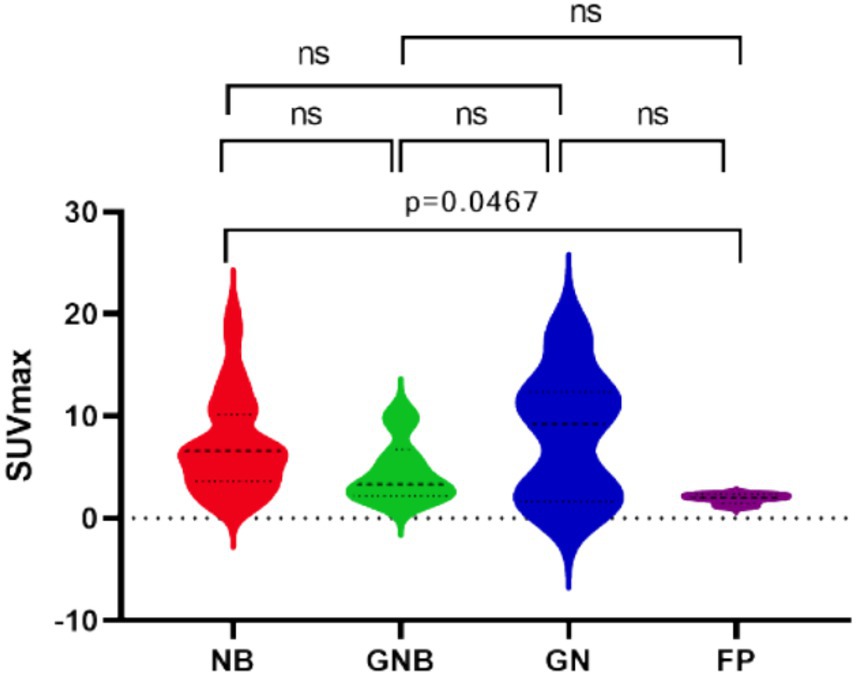
Figure 3. One-way ANOVA 18F-AlF-NOTATATE parameters (SUVmax) of NB in different pathologic. NB, Neuroblastoma; GNB, Ganglioneuroblastoma; GN, Ganglioneuroma; FP, False Positive.
Discussion
In this study, by comparing 18F-AlF-NOTATATE PET/CT and conventional imaging (same-computer CT with/without simultaneous enhanced MRI) in all patients, 18F-AlF-NOTATATE PET/CT was found to be more sensitive than conventional imaging for detecting residual lesions after chemotherapy in patients with high-risk NB, especially in detecting residual bone, bone marrow, and lymph node occult lesions. The higher sensitivity and specificity of the technique could potentially be an important alternative to 123I-MIBG imaging to improve the accuracy of restaging after chemotherapy for patients with high-risk NB and help clinicians revise treatment strategies in a timely manner to improve patient prognosis. In addition, in the surgical subgroup analysis, the SUVmax showed potential for screening NB and false-positive lesions.
In this study, we observed that in patients with high-risk NB who underwent induction, consolidation, or post-consolidation chemotherapy, the residual lesions were predominantly distant metastases, similar to previously reported results (4). The incidence of bone and bone marrow metastases in this study was high (51%), and the metastases were widely distributed, mainly accumulating in the limb bones and spine. In addition, lymph node metastasis was more common, with abdominopelvic and retroperitoneal lymph node metastasis prevalent in NB originating in the retroperitoneum and mediastinal and clavicular lymph node metastasis predominating in NB located in the posterior mediastinum. Smaller lymph node metastases were clearly observed by high uptake on 18F-AlF-NOTATATE PET. Further analysis showed that the Krenning score of residual lesions after chemotherapy was predominantly 1–2 on 18F-AlF-NOTATATE PET/CT. This suggests that by using 18F-AlF-NOTATATE PET/CT to detect high-risk NB post-chemotherapy, residual lesions can be correctly identified, even with a low SUVmax.
Secondly, this study investigated the diagnostic efficacy of 18F-AlF-NOTATATE PET/CT in the restaging of high-risk NB after chemotherapy and compared it with the co-located CT ± contemporaneous liver/brain-enhanced MRI. The results revealed that 18F-AlF-NOTATATE PET/CT demonstrated higher diagnostic efficacy, particularly in terms of sensitivity, specificity, and accuracy, in the patient-based and lesion-based analyses. This result is similar to that of Rahaf et al., who compared the effects of 68Ga-DOTATATE PET/CT and MRI on the restaging and assessment of treatment response in eight children with NB (7).
In the lesion-based analysis, 18F-AlF-NOTATATE PET/CT was found to be more sensitive in detecting the localization of residual lesions in the bone, bone marrow, and occult lymph nodes. This result may be attributed to the size reduction of residual lesions after chemotherapy and the reduction in tumor activity. CT has a low detection rate for diagnosing tiny lesions (<1 cm) in the peritoneum, lymph nodes and bone due to partial volume effect (12, 13). It is well-known that after treatment, PET functional imaging is usually able to detect residual lesions better than CT/MRI (14). The limitations of CT/MRI in the assessment of bone and bone marrow involvement arise mainly from the limitations of its imaging range, as CT or MRI is usually acquired in a dedicated field of view or is confined to axial areas (e.g., abdomen and thorax), whereas PET/CT provides whole-body detection modalities. In addition, CT/MRI is prone to misdiagnosis in the assessment of residual bone and bone marrow lesions after NB chemotherapy, mainly because patients often have irreversible changes in bone mineral density and morphology despite effective control of tumor activity after treatment. In the detection of lymph node lesions, CT is diagnosed by measuring the short meridian of the lymph nodes (usually, a short meridian of more than 1.5 cm is considered a metastatic lymph node), whereas PET is determined by the uptake of 18F-AlF-NOTATATE. Thus, PET/CT demonstrated greater sensitivity for detecting lymph node metastasis. It is worth noting that although 18F-AlF-NOTATATE PET/CT performed well in most aspects, its sensitivity was slightly lower than that of conventional imaging techniques in the detection of residual lesions in the liver, which may be due to the uptake of 18F-AlF-NOTATATE by normal cells in the liver, resulting in lower target samples of liver lesions, which may mask some of the small foci. The same has been found in previous studies (15). 18F-AlF-NOTATATE PET/CT was slightly less accurate than MRI in detecting residual brain lesions, with three missed cases. This finding suggests that a combination of imaging techniques should be used for the diagnosis of brain and liver metastases to improve diagnostic accuracy.
In this study, although 18F-AlF-NOTATATE PET/CT showed significant advantages in detecting residual lesions of NB, 11 cases of residual lesions were not detected. Based on previous research (16), the possible reasons for these non-detection cases were explored in depth and are now attributed to the following: (1) The residual lesions had a low level of SSTR expression, which led to a reduction in the contrast of the lesions on PET/CT imaging and posed a diagnostic difficulty. (2) Influence of the high radiological background region: If the residual lesion was located in a region with a high radiological background, such as the liver, spleen, or bladder, the uptake of 18F-AlF-NOTATATE by normal cells or tissues in these regions may have been higher, thus masking 18F-AlF-NOTATATE uptake in the region of the residual lesion, which made it difficult for the lesion to be detected. (3) Concealment and size limitation of residual lesions: When the size of the residual lesions was too small, in a concealed location, or in proximity to the primary foci, these lesions may have been difficult to detect accurately owing to the partial volume effect of PET/CT and the limitation of spatial resolution. Additionally, a low degree of 18F-AlF-NOTATATE uptake was observed at sites of inflammation/infection, post-radiotherapy alterations, and osteoblastic activity.
In the patient-based analyses, 18F-AlF-NOTATATE PET/CT showed improved specificity, PPV, and ACC for restaging high-risk NB after chemotherapy. This may be attributed to the accurate identification of residual bone and bone marrow lesions using PET/CT after chemotherapy. These findings provide a more accurate diagnostic basis for restaging high-risk patients with NB.
Finally, in the one-way ANOVA, the SUVmax demonstrated some potential in screening NB and false-positive lesions but was unable to effectively differentiate between GN transformations after NB treatment. Post-treatment GN transformation of NB is a complex biological phenomenon that often occurs during post-treatment follow-up. This transformation may lead to changes in the metabolic properties of the primary lesion, rendering the SUVmax unable to accurately reflect its pathophysiological status. Future studies should explore the use of SUVmax in combination with other clinical indicators to improve the diagnostic accuracy of GN transformation after NB treatment. Simultaneously, researchers can explore new imaging parameters to assess changes in metabolic activity in NB and provide clinicians with more accurate diagnostic and therapeutic decision support.
This study had some limitations. First, the sample size was relatively small, which may have some impact on the stability and reliability of the results. Second, owing to the retrospective nature of the study, some patients were scanned using various CT, MRI, and PET protocols with different scanners, resulting in inconsistent imaging parameters. Finally, some NB cases were confirmed histopathologically via tumor biopsies and radiographic follow-ups. However, sampling and radiographic features may not be representative owing to intratumoral expression heterogeneity.
Conclusion
Our results demonstrate that 18F-AlF-NOTATATE PET/CT has significantly better diagnostic efficacy than conventional imaging in the restaging of high-risk NB after chemotherapy, especially in the detection of occult lesions, which may help improve the accuracy of NB restaging, thus providing physicians with more accurate diagnostic information and guiding more effective treatment options. Despite the excellent performance of 18F-AlF-NOTATATE PET/CT for the detection of occult lesions, it is important to note the limitations of this technique. Nodular cell neuroma and inflammatory lymph nodes may be misdiagnosed, and liver and brain metastases may be underdiagnosed. Future studies should explore how to maximize the use of 18F-AlF-NOTATATE PET/CT in combination with other imaging methods to achieve a more comprehensive and accurate neuroblastoma diagnosis.
Data availability statement
The original contributions presented in the study are included in the article/supplementary material, further inquiries can be directed to the corresponding authors.
Ethics statement
The present retrospective study, in accordance with the principles outlined in the Declaration of Helsinki, obtained approval from the Ethics Committee of Shandong Cancer Hospital and Institute. The studies were conducted in accordance with the local legislation and institutional requirements. Written informed consent for participation in this study was provided by the participants’ legal guardians/next of kin. Written informed consent was obtained from the individual(s), and minor(s)’ legal guardian/next of kin, for the publication of any potentially identifiable images or data included in this article.
Author contributions
HW: Project administration, Supervision, Writing – original draft, Formal analysis, Software, Visualization, Data curation, Methodology, Conceptualization, Investigation, Validation. DZ: Project administration, Writing – review & editing, Validation, Investigation, Funding acquisition. FZ: Visualization, Investigation, Writing – review & editing, Software. YS: Formal analysis, Investigation, Writing – review & editing. YL: Writing – review & editing, Visualization, Data curation, Investigation. HY: Visualization, Writing – review & editing, Investigation. JW: Conceptualization, Supervision, Data curation, Methodology, Writing – review & editing, Funding acquisition, Resources. XS: Methodology, Writing – review & editing, Data curation, Supervision, Project administration, Conceptualization, Resources, Funding acquisition.
Funding
The author(s) declare that financial support was received for the research and/or publication of this article. This work was financially supported by National Natural Science Foundation of China (Nos. 82373424).
Conflict of interest
The authors declare that the research was conducted in the absence of any commercial or financial relationships that could be construed as a potential conflict of interest.
Generative AI statement
The authors declare that no Gen AI was used in the creation of this manuscript.
Publisher’s note
All claims expressed in this article are solely those of the authors and do not necessarily represent those of their affiliated organizations, or those of the publisher, the editors and the reviewers. Any product that may be evaluated in this article, or claim that may be made by its manufacturer, is not guaranteed or endorsed by the publisher.
References
1. Maris, JM, Hogarty, MD, Bagatell, R, and Cohn, SL. Neuroblastoma. Lancet. (2007) 369:2106–20. doi: 10.1016/S0140-6736(07)60983-0
2. Johnsen, JI, Dyberg, C, and Wickström, M. Neuroblastoma-a neural crest derived embryonal malignancy. Front Mol Neurosci. (2019) 12:9. doi: 10.3389/fnmol.2019.00009
3. Calabrese, FM, Clima, R, Pignataro, P, Lasorsa, VA, Hogarty, MD, Castellano, A, et al. A comprehensive characterization of rare mitochondrial DNA variants in neuroblastoma. Oncotarget. (2016) 7:49246–58. doi: 10.18632/oncotarget.10271
4. Matthay, KK, Maris, JM, Schleiermacher, G, Nakagawara, A, Mackall, CL, Diller, L, et al. Neuroblastoma. Nat Rev Dis Primers. (2016) 2:16078. doi: 10.1038/nrdp.2016.78
5. Matthay, KK, Shulkin, B, Ladenstein, R, Michon, J, Giammarile, F, Lewington, V, et al. Criteria for evaluation of disease extent by 123I-metaiodobenzylguanidine scans in neuroblastoma: a report for the international Neuroblastoma risk group (INRG) task force. Br J Cancer. (2010) 102:1319–26. doi: 10.1038/sj.bjc.6605621
6. Sharp, SE, Shulkin, BL, Gelfand, MJ, Salisbury, S, and Furman, WL. 123I-MIBG scintigraphy and 18F-FDG PET in neuroblastoma. J Nucl Med. (2009) 50:1237–43. doi: 10.2967/jnumed.108.060467
7. AlSadi, R, Maaz, A, Bouhali, O, and Djekidel, M. (68)Ga-DOTATATE PET in restaging and response to therapy in neuroblastoma: a case series and a mini review. J Nucl Med Technol. (2023) 51:140–6. doi: 10.2967/jnmt.122.264694
8. Sadowski, SM, Neychev, V, Millo, C, Shih, J, Nilubol, N, Herscovitch, P, et al. Prospective study of 68Ga-DOTATATE positron emission tomography/computed tomography for detecting gastro-entero-pancreatic neuroendocrine tumors and unknown primary sites. J Clin Oncol. (2016) 34:588–96. doi: 10.1200/JCO.2015.64.0987
9. Pauwels, E, Cleeren, F, Tshibangu, T, Koole, M, Serdons, K, Dekervel, J, et al. [(18)F]AlF-NOTA-octreotide PET imaging: biodistribution, dosimetry and first comparison with [(68)Ga]Ga-DOTATATE in neuroendocrine tumour patients. Eur J Nucl Med Mol Imaging. (2020) 47:3033–46. doi: 10.1007/s00259-020-04918-4
10. Pauwels, E, Cleeren, F, Tshibangu, T, Koole, M, Serdons, K, Boeckxstaens, L, et al. (18)F-AlF-NOTA-octreotide outperforms (68)Ga-DOTATATE/NOC PET in neuroendocrine tumor patients: results from a prospective, multicenter study. J Nucl Med. (2023) 64:632–8. doi: 10.2967/jnumed.122.264563
11. Krenning, EP, Valkema, R, Kooij, PP, Breeman, WA, Bakker, WH, DeHerder, WW, et al. Scintigraphy and radionuclide therapy with [indium-111-labelled-diethyl triamine penta-acetic acid-D-Phe1]-octreotide. Ital J Gastroenterol Hepatol. (1999) 31:S219–23.
12. Liu, Y, Chen, W, Cui, W, Liu, H, Zhou, X, Chen, L, et al. Quantitative pretreatment CT parameters as predictors of tumor response of neuroendocrine tumor liver metastasis to transcatheter arterial bland embolization. Neuroendocrinology. (2020) 110:697–704. doi: 10.1159/000504257
13. Rockall, AG, and Reznek, RH. Imaging of neuroendocrine tumours (CT/MR/US). Best Pract Res Clin Endocrinol Metab. (2007) 21:43–68. doi: 10.1016/j.beem.2007.01.003
14. Fiebrich, HB, Brouwers, AH, Kerstens, MN, Pijl, MEJ, Kema, IP, de Jong, JR, et al. 6-[F-18]Fluoro-L-dihydroxyphenylalanine positron emission tomography is superior to conventional imaging with (123)I-metaiodobenzylguanidine scintigraphy, computer tomography, and magnetic resonance imaging in localizing tumors causing catecholamine excess. J Clin Endocrinol Metab. (2009) 94:3922–30. doi: 10.1210/jc.2009-1054
15. Privitera, L, Hales, PW, Musleh, L, Morris, E, Sizer, N, Barone, G, et al. Comparison between diffusion-weighted MRI and (123) I-mIBG uptake in primary high-risk Neuroblastoma. J Magn Reson Imaging. (2021) 53:1486–97. doi: 10.1002/jmri.27458
Keywords: neuroblastoma, positron emission tomography/computed tomography (PET/CT), 18F-AlF-NOTATATE, restage, chemotherapy
Citation: Wang H, Zuo D, Zheng F, Sun Y, Liu Y, Yang H, Wang J and Sun X (2025) The value of 18F-AlF-NOTATATE PET/CT in restaging high-risk neuroblastoma after chemotherapy. Front. Med. 12:1596272. doi: 10.3389/fmed.2025.1596272
Edited by:
Igor Yakushev, Technical University of Munich, GermanyReviewed by:
Aditi Mulgaonkar, University of Texas Southwestern Medical Center, United StatesZehra Pinar Koç, Mersin University, Türkiye
Copyright © 2025 Wang, Zuo, Zheng, Sun, Liu, Yang, Wang and Sun. This is an open-access article distributed under the terms of the Creative Commons Attribution License (CC BY). The use, distribution or reproduction in other forums is permitted, provided the original author(s) and the copyright owner(s) are credited and that the original publication in this journal is cited, in accordance with accepted academic practice. No use, distribution or reproduction is permitted which does not comply with these terms.
*Correspondence: Jingfu Wang, d2FuZ2ppbmdmdTY2NkAxNjMuY29t; Xiaorong Sun, eHJzdW5Ac2RmbXUuZWR1LmNu
†ORCID: Xiaorong Sun, orcid.org/0000-0001-8520-9556
 Han Wang
Han Wang Di Zuo3
Di Zuo3 Fei Zheng
Fei Zheng Yingying Sun
Yingying Sun Yuxuan Liu
Yuxuan Liu Xiaorong Sun
Xiaorong Sun